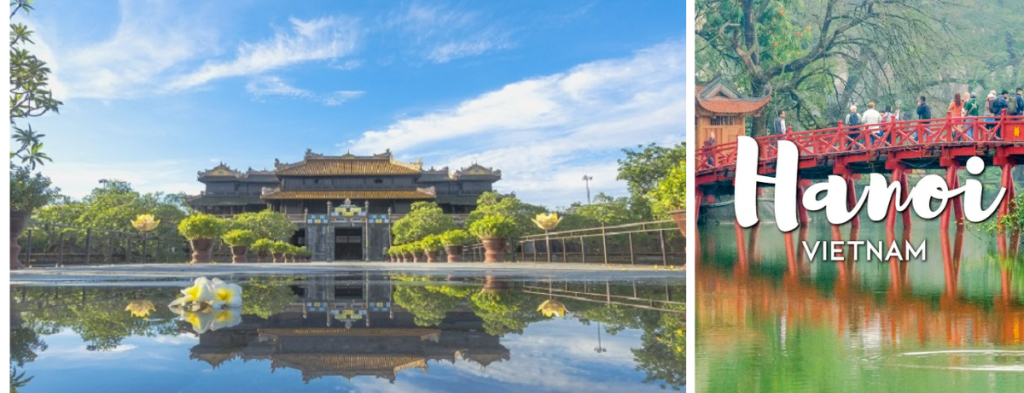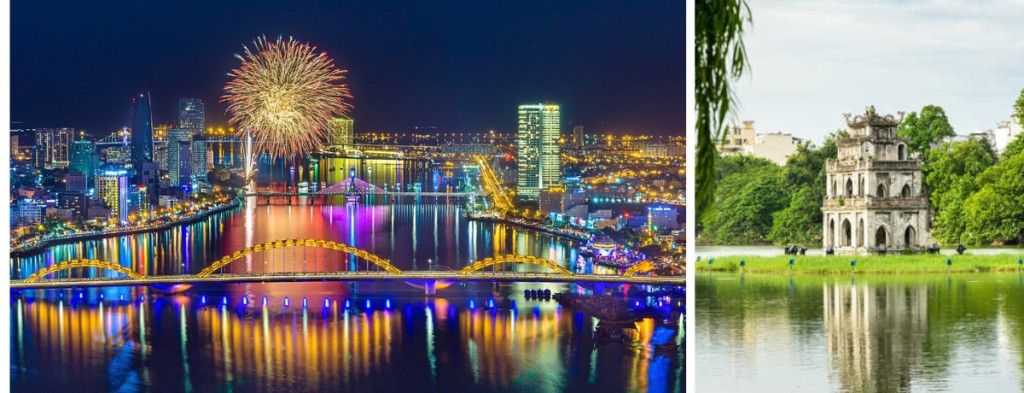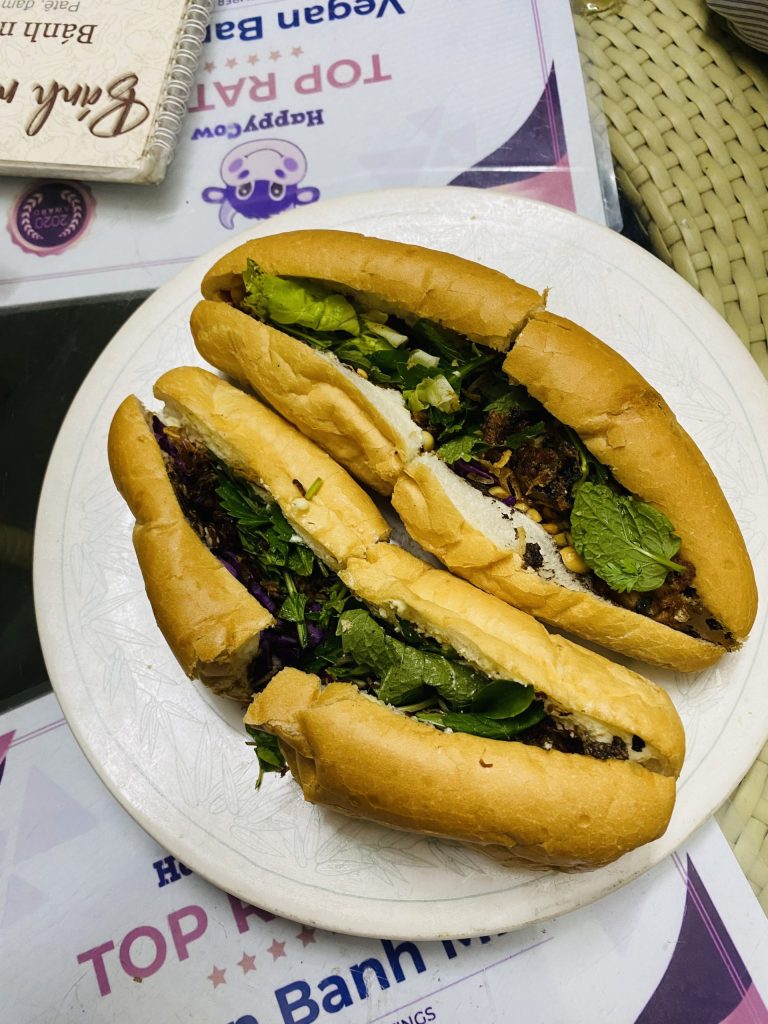Suppose the Old town of Hanoi fascinates visitors with its wonderful thousand-year-old heritage engulfed in traces of time. In that case, the capital also attracted a French-carved appearance for nearly three-quarters of a century, known as the Hanoi French Quarter.
Civil, institution or religion, the colonial buildings of various styles and, over a century, coexist those contemporary in beautiful harmony. And this gives the City of Hanoi a special charm, an architectural and urban heritage unique not only in Indochina but also in Asia.
Today, what do we call the Paul Doumer Bridge, the Louis Finot Museum, the Protectorate College, and many other places full of recollection? Lovers of architecture and history, a tour of downtown Hanoi will undoubtedly satisfy you.
The Opera of Hanoi (1901 – 1911)

Located at August Revolution Avenue, facing Trang Tien Street leading to Hoan Kiem Lake, this magnificent building stands out as one of the most prominent colonial eras. Built-in 1901 and completed after ten years, it was the gathering of Western artists, symboling the wealthiest. Adapting to the tropical characteristics, Harley and Broyer designed the Opera Garnier of Paris by evoking the colors and silhouettes of the operas of the South of France.
→ Read more: 21 Best Things to Do in Hanoi’s French Quarter – From Famous Local Cafes to Iconic Ice Cream
The Cathedral of Saint Joseph (1884-1887)

Reminding of Hanoi, we can miss one of the majestic monuments – the first Catholic cathedral built in Hanoi and still stands out as the most important in the city. Marked by the Western architecture of the twelfth century and the Renaissance, it was inspired by the cathedral of Notre Dame de Paris with large arcades in front. The high place of Hanoi’s religion is also a stop for pedestrians and tourists who find themselves admiring one of the oldest buildings in French architecture.
→ Read more: Exploring the Beauty of St. Joseph’s Cathedral
The National Museum of the History of Vietnam (1926 – 1932)

The National Museum of the History of Vietnam (1926 1932)
The oldest national museum, the National Museum of the History of Vietnam, located at 1 Trang Tien Street, is inherited from the Louis Finot Museum, attached to the French School of Extreme East. One of the most visited of Hanoi, you may be attracted by exceptional collections of the material heritage of the country.
Designed by architects C.Batteur and E.Hébrard, it is a typical Indochinese architecture combining western and oriental styles. Despite a shape reminiscent of old Chinese buildings, its double roof represents the traditional Vietnamese style.
The Long Bien Bridge (1898-1902)

With more than 2 kilometers in length, this bridge spanning the Red River was the most imposing of Indochina in the nineteenth century, which can be seen in Daydé & Pillé – Paris, the owner’s name. Yet, serving the war with a dozen bombing lives, this old iron veteran lives secluded by quietly doing the capital’s trains and two wheels. Linking past and present, for Vietnamese, Long Bien Bridge is one of the best storytellers in nearly a century of the capital’s history.
The National University of Vietnam, former University of Indochina (1923 – 1926)

Found at 19 Le Thanh Tong Street, the building affected by Indochinese architecture is now the seat of the National University of Vietnam. Considered the first university institution founded by the French in the country, the Vietnamese University was founded at 19 Le Thanh Tong Street, the building affected by Indochinese architecture is now the seat of the National University of Vietnam. Considered the first university institution founded by the French, the University of Indochina aimed to train senior intellectuals from the region’s three countries. Signed by Ernest Hebrard, this imposing and charming construction highlights the historical and architectural sites of Hanoi.


The State Bank of Vietnam, former bank of Indochina in Hanoi (1875)

The former branch of the Indochina Bank was established in 1875 by the French President. The State Bank of Vietnam is located at the end of the Paul Bert Garden or current Ly Thai To Garden, in front of Hoan Kiem Lake.

A most remarkable Art Deco style represents the building in Hanoi with traditional touches raised by ancient Vietnamese motifs. The two other subsidiaries of the Bank of Indochina remain in two major cities, Haiphong in the north and Ho Chi Minh City in the south, all of which attract a unique architecture.
The Presidential Palace of Hanoi, the residence of the Governor-General of Indochina (1900 – 1906)

In Top 13 most beautiful palaces in the world by American magazine Architectural Digest, Presidential In the Top 13, most beautiful palaces in the world by the American magazine Architectural Digest, the Presidential Palace in Hanoi has used the residence of the Governor-General of Indochina. Located in the Rue La Republique or Hoang Van Thu today, facing the current Puginier Square or Ba Dinh Square, the work designed by Auguste Henri Vildieu invites you to admire the most significant neoclassical landmark in Hanoi, the most luxurious and expensive construction of its time.
Chu Van An College, former Protectorate College (1908)

Established by the French in 1908, Chu Van An College was one of the most beautiful of its kind, known as the Protectorate College. It was also called Buoi College by Vietnamese teachers and students for its location in Buoi Village. The building Bat Giac or the Octagon, the Director’s residence, is the first flag for the elegant architecture of the villa Schneider Manson bearing the first owner’s name. With the financial support of the Île-de-France region, this beautiful house was renovated and refurbished in 1999 to become a library.
The Dong Xuan Market (1890)

In the heart of Hanoi’s Old Quarter, Dong Xuan Market is one of Hanoi’s most bustling markets, a great attraction whose history goes back to the reign of the Nguyen dynasty. It was held outdoors until 1890, when the French began construction by installing the iron frame. Despite the fire in 1994, the original architecture has been respected as it is today. Since 2003, this place has welcomed pedestrians to stroll around in the evening and discover the night market of Hanoi that connects Dong Xuan, Hang Dao, to Hoan Kiem Lake.
The headquarters of the daily newspaper Le Nouveau Hanoi, former hotel of the Future of Tonkin in Hanoi (1893)

Just two minutes walking from Hoan Kiem Lake at 44 Ly Thai To Street, you can find one of the most beautiful French buildings dating from the late nineteenth century. It is a hotel of the Future of Tonkin in Hanoi. The modern structure of New Hanoi is distinguished by its typical Art Nouveau appearance, trendy during the colonial period. It is a typical Art Nouveau appearance, very popular during the colonial period.
The French Quarter itself has plenty of remnants of the times you will learn about! Exploring Hanoi on your own or joining the best Hanoi French Quarter Walking Tour to learn even more beyond the area. You will learn so much about how Vietnamese society changed under French rule and explore the bad and the good of this period.
Our local walking experience has been ranked as the top choice on Airbnb Experience and TripAdvisor. Come join us for a unique and unforgettable journey!













